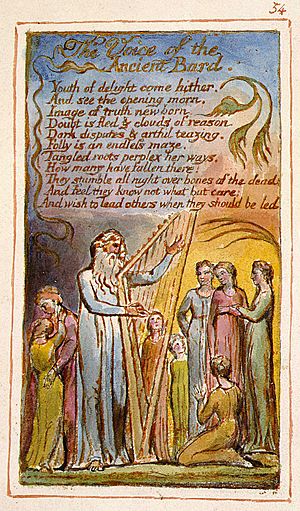The Voice of the Ancient Bard facts for kids
The Voice of the Ancient Bard is a poem written by the English poet William Blake. It was published as part of his collection Songs of Innocence in 1789, but later moved to Songs of Experience, the second part of the larger collection Songs of Innocence and of Experience, 1794.
Poem
The following is a transcription of the poem:
Youth of delight come hither.
And see the opening morn,
Image of truth new born.
Doubt is fled & clouds of reason
Dark disputes & artful teazing.
Folly is an endless maze,
Tangled roots perplex her ways.
How many have fallen there!
They stumble all night over bones of the dead
And feel they know not what but care;
And wish to lead others when they should be led.
Gallery
-
SI, copy B, 1789 (Library of Congress)
-
SI, copy G, 1789 (Yale Center for British Art)
-
SI&E, copy C, 1789, 1794 (Library of Congress)
-
SI&E, copy L, 1795 (Yale Center for British Art)
-
SI&E, copy Y, 1825 (Metropolitan Museum of Art)
-
SI&E, copy Z, 1826 (Library of Congress)
Musical settings
The poem has been set to various different musical scores:
- John Harbison (b.1938), USA: The Voice of the Ancient Bard, No. 4 from Five Songs of Experience, for 4 soli, SATB chorus, string quartet and percussions, 1971
- Gary Higginson (b.1952), UK: The Voice of the Ancient Bard, No. 7 from Seven Songs of Experience (set no. 2), for SATB, 1981-2
- Chester Edward Ide (1878—1944), USA: The Voice of the Ancient Bard. No.8 from Songs of Innocence—Eight Poems by William Blake, for two treble voices a capella, 1928.
- Joan Anne Littlejohn (b. 1937), UK: The Voice of the Ancient Bard. No.1 from Songs of Experience (part II of Songs of Innocence and of Experience ), for voice and piano, 1967-70
- Leo Smith (1881–1952), Canada: The Voice of the Ancient Bard, for voice and piano, c. 1900
- Tod Machover (b. 1953), USA: In the opera Skellig, 2008










